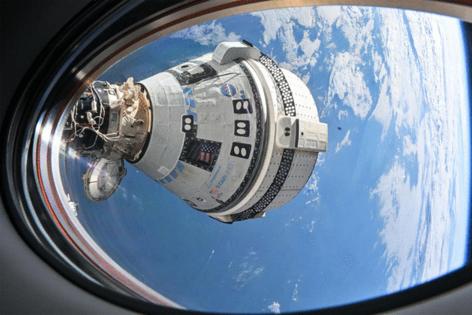With delay until 2026, Boeing Starliner next flight may not carry humans, NASA says
Published in News & Features
As SpaceX prepares to send up its 19th Dragon spacecraft with humans on board, the Boeing Starliner — which has only completed half of a crewed mission to date — remains in fix-it mode.
Its next launch is scheduled for no earlier than 2026, and then maybe not even one with crew, according to NASA.
In a press conference for the SpaceX Crew-11 launch earlier this month, NASA Commercial Crew Program manager Steve Stich updated progress on getting Starliner back up and running as the second of NASA’s two commercial launch providers that are supposed to share duties of ferrying astronauts to and from the International Space Station.
“We really are working toward a flight as soon as early next year for Starliner,” he said. “And then ultimately, our goal is to get into crew rotation flights with Starliner, and those would start no earlier than the second rotation slot at the end of next year.”
At issue was that when Starliner launched on the Crew Flight Test (CFT) on June 5, 2024 from Cape Canaveral, it developed several helium leaks and thruster failures in the propulsion system before docking with the space station the following day. What was supposed to be an eight-day stay on board stretched into the summer with NASA ultimately electing to fly Starliner home without crew in September.
While it landed safely, Boeing and NASA have analyzed the source for the problems, and for now have elected to find new sealant material to address the helium leaks and explore several hardware changes to deal with what was determined to be overheated thrusters.
Stich said testing was taking places in multiple locations across the country, but a lot of the work is being done on the White Sands Test Facility in New Mexico. That includes putting into a test stand what he called a doghouse, which is the casing within which the individual thrusters are contained on the spacecraft. The doghouse is ultimately the enclosure that was partly responsible for retaining the heat created by their use.
“That testing is scheduled to start toward the end of next month, and so we’re making a lot of progress and understanding the thermal performance,” he said. “These will build the informed thermal modeling.”
He also said Boeing was adding hardware that would draw heat away from the thruster as well as adding some thermal barriers that would keep heat from coming back up into the doghouse.
“So that’s showing a lot of progress compared to the original design of the thruster,” he said.
While its next flight won’t be until 2026, Stich said the decision has yet to be made as to whether it would be with crew or just a cargo mission.
“We’re still looking at that, whether it to be a cargo flight or not. I think there’s a lot of advantages, I would say, to flying a cargo flight first. If we really look at the history of Starliner and both Dragon, I think Dragon benefited a lot from having earlier flights before the crew contract,” he said.
But it ultimately depends on the results of testing.
“What we’re really looking at is, can we test all the changes that we are making to the doghouses, in particular, on the ground, and would we want to validate those in flight first? And so there’s a strong chance we’ll fly a cargo flight first,” he said. “That’s still in front of us.”
Meanwhile, SpaceX keeps rolling along with the Crew-11 launch targeting as early as July 31 for liftoff from Kennedy Space Center’s Launch Pad 39-A. The Crew Dragon Endeavour, which was the first of SpaceX’s fleet of five Crew Dragons to fly with humans in May 2020, is making its record fifth launch. Its passengers are NASA astronauts Zena Cardman and Mike Fincke, JAXA (Japan Aerospace Exploration Agency) astronaut Kimiya Yui and Roscosmos cosmonaut Oleg Platonov.
They’re to relieve Crew-10, who rode up on board the Crew Dragon Endurance which has been attached to the space station since arriving in March. SpaceX’s Demo-2 test mission in 2020 marked the first launch of NASA astronauts from U.S. soil since the end of the Space Shuttle Program nine years earlier. The interim saw a reduced population on the station with NASA relying on Russian Soyuz launches to get its astronauts into space.
SpaceX followed up the test flight with its first operational mission, Crew-1, later in 2020, and has since flown 10 crew rotation missions as well as seven private launches of its Crew Dragon. The four members of Crew-11 will bring the total number of humans flown by SpaceX to 74 in just over five years.
That includes Butch Wilmore and Suni Williams, the pair of NASA astronauts who flew up to the station on the test flight of Starliner last summer, but ultimately made the return trip on board a Crew Dragon when NASA decided Starliner’s issues with helium leaks and thruster failures was too risky.
While Starliner returned to Earth without crew after three months attached to the space station, Williams and Wilmore didn’t get back home until March 2025, flying home with Crew-9 after spending 9 1/2 months on board.
The need to shuffle the pair onto a Crew Dragon for the flight home meant the removal of the original commander of Crew-9 along with another NASA astronaut to leave room for the Starliner duo. That commander was Cardman, who now reassigned as Crew-11 commander is making her debut trip to space.
Fincke was also tapped to fly on what was supposed to be first rotational flight of Starliner, Starliner-1, and was the backup to Williams and Wilmore on CFT, while Japan’s Yui was also trained to fly on Starliner.
With Starliner-1’s delay potentially until late 2026, though, the pair joined Cardman on the Crew-11 roster.
NASA originally ordered six operational missions from Boeing worth $4.6 billion and from SpaceX for $2.6 billion. With Starliner delays, SpaceX has now landed 14 operational mission contracts and about to fly its 11th, while Boeing has yet to fulfill its first.
At only two flights to the station per year, NASA only needs enough to staff that station through 2030, after which it will be safely decommissioned and brought back down to burn up in Earth’s atmosphere. In the meantime, NASA is looking to certify missions to last up to eight months instead of the normal six, which could reduce further the number of flights needed through 2030.
“It’s really too early to speculate how many flights we’ll fly with each provider, SpaceX and Boeing, but you know, we are looking at that, looking at the station life,” he said.
Stich said it’s possible contracted missions could spill over to help support the new commercial space stations that are being worked on by companies like Axiom Space and Blue Origin, and should be operational before 2030.
“We’re also looking ahead toward commercial LEO (low-Earth orbit) and toward the commercial LEO destinations, and preserving transportation capability, both cargo and crew for those destinations,” he said. “Right now, we’re taking it one step at a time, and the first step in front of us is Crew-11.”
----------------
©2025 Orlando Sentinel. Visit at orlandosentinel.com. Distributed by Tribune Content Agency, LLC.







Comments